My thesis was about the Rescue of Patrimonial Inhabiting in the Region of Atacama, Chile. I created an educational platform for cultural exchange between locals and foreigners through the restoration of vernacular vernacular shelter generating a platform for residencies and retreats that could strengthen and nourish the Atacamanian cultural patrimony, which is currently under threat of extinction.
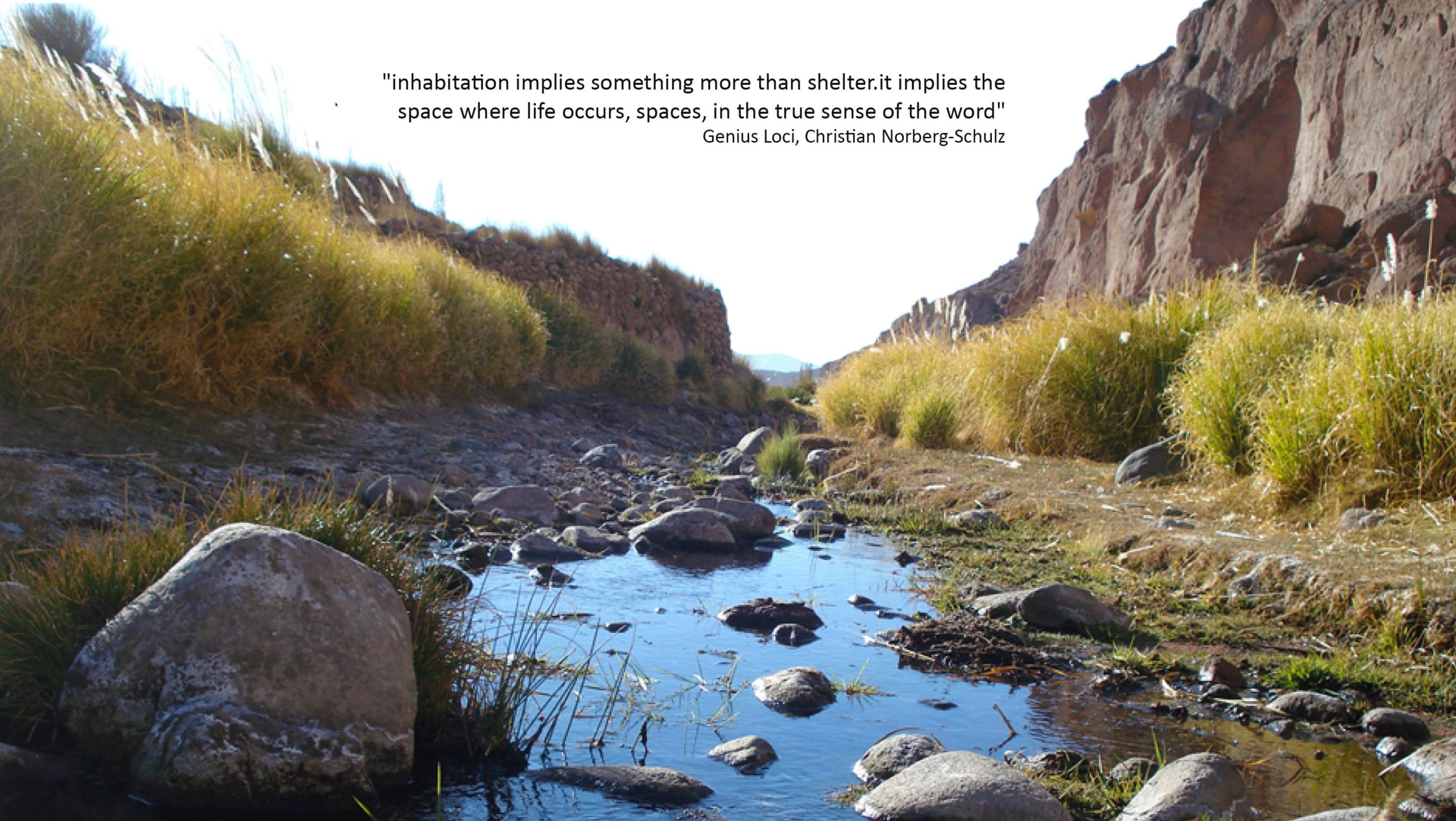
The thesis originates from a personal interest in comprehending man’s way of inhabiting upon the Earth; in other words, understanding the relationship that man builds with the territory and it’s different elements (climate, geomorphology, water, vegetation and wildlife), as well as the way in which a culture builds.
The project is based on the research of ancient culture, Atacamans, in an inhospitable territory, Atacama Desert, which has allowed the culture to remain true to its indigenous development.
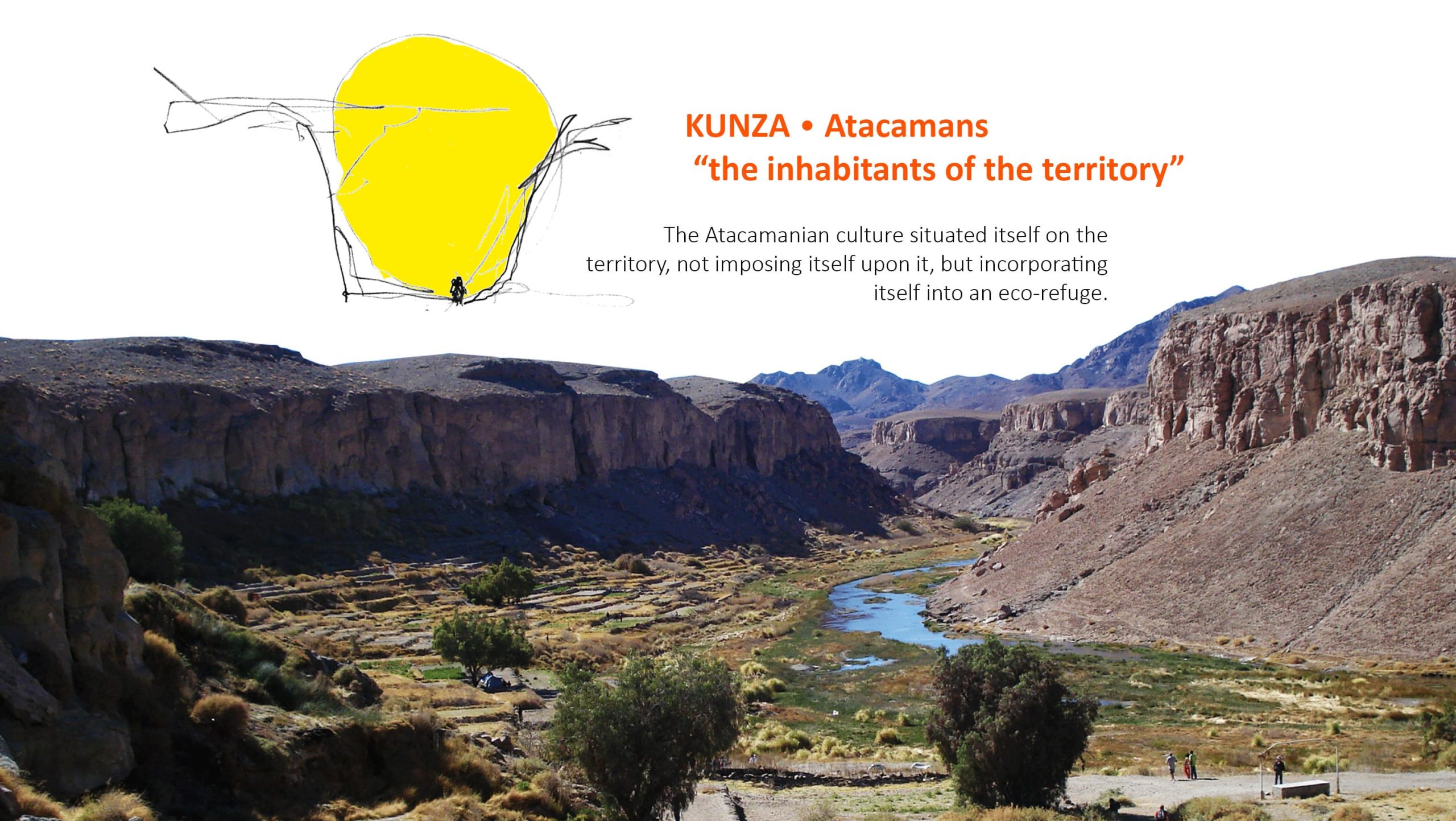
The research explored the region’s physical changes due to a climate change of the last 10,000 years, and mapped the location and settlement ways of Atacamans during their continue adaptation of a landscape that is getting dry. And emphasizing on the dwellings’ constructive detail and relationships with the landscape. This way, I am able to develop a clear and complete timeline regarding man’s way of inhabiting the Atacama according to climate, history, culture and architecture, together with a general plan of the studied area, which reveals the settlements’ logic and history and communication with the territory and foreign cultures.
The analysis of this study reveals the logic and values of the Atacamans constructions and settlements, which are deeply set in the territory in a transcendental way, reflected in the culture’s gods, which are elements that make up the landscape: Mountain, Water and Earth. I then travel to the territory in question in order to observe and register the actual reality of the Atacamanian’s way of inhabiting. I visit each town and city in the region, studying it and extract census data from recent years. The quality of life in local villages heavily contrasts with quality of life in new urbanizations, which possess the highest suicide rates in the county after Santiago, the capital. Today, around 95% of children between ages 12 and 13 migrate to cities searching for a national education, which promotes their integration into a global society but does not rescue the essential values of their local cultures. This uproots the children from their origins.
The project is based in Caspana, the only Atacamanian settlement with population growth in the region. Life in Caspana is simple and peaceful; people love their village, and they are a truly exemplary community to the rest of the nation.
The Atacamanian’s form of urbanization spawns from the order and canalization of water; the waterways are the first lines to structure the landscape. These lines are drawn horizontally down the foothills of the sloped grounds, as a way of watering the crops downhill. Water is the fundamental element for fundamental and structural survival. This is how man begins to conquer the territory through water canals, which not only provide for the crops and household use, but also organize and structure the territory. A new order is drawn over the territory: a functional existential order, necessary in order to inhabit and cultivate it.

This is how water canals structure the settlements and configure the use of the ground. Atacamanian settlements prioritize grounds that are suitable for cultivation, placing their homes upon land that is not suitable for planting and protected from the excessive wind of some places.
The agricultural terraces are located continuously along the gorge on irregular geometry based upon a rectangle that is blurred in order to take the shape of the territory, slope, or specific situation in which it appears. Constructed through pircas (contention walls made out of irregularly shaped stones, never higher than 2m), the agricultural terraces create great extensions of green areas and fertile grounds in the desert. At the same time, the cultivation terraces scale the landscape down.
On the other hand, the Atacamanian constructions respond to the specific climatic needs of a desert dwelling. This is why they present themselves as compact eco-refuges, isolated from the great daily temperature oscillations.
The rectangular shape is the reflection of an object: an object that poses upon the territory like a compact interior, an object that holds insulation as it’s ultimate purpose. The perforations (doors and windows) are scarce and reduced in size, as a way of avoiding contact with the exterior and loss of the interior’s temperature. They are dark and low constructions, with thick walls that absorb the heat during the day and keep the interiors fresh, in order to release it at night and protect its dwellers from the low nighttime temperatures.
Above everything else, the dwelling is structured as a single, continuous precinct that houses several different domestic places within its length, all immersed in a common interior.
The strong solar radiation during the day and the low temperatures at night materialized themselves in insulated interiors and compact objects superimposed upon the territory, which give way to man’s inhabitation. These interiors find themselves isolated from the exterior, not only in climatic aspects but also in spatial aspects, causing the loss of links and communication between a domesticated functional, domesticated interior and an extensive, uncontrollable exterior. The intermediate space is born product of this duality, as a response to a need for non-functional inhabiting. It becomes an architectonic fact that allows for dialogue between the landscape and the interior, giving way to man’s existential space in the place.
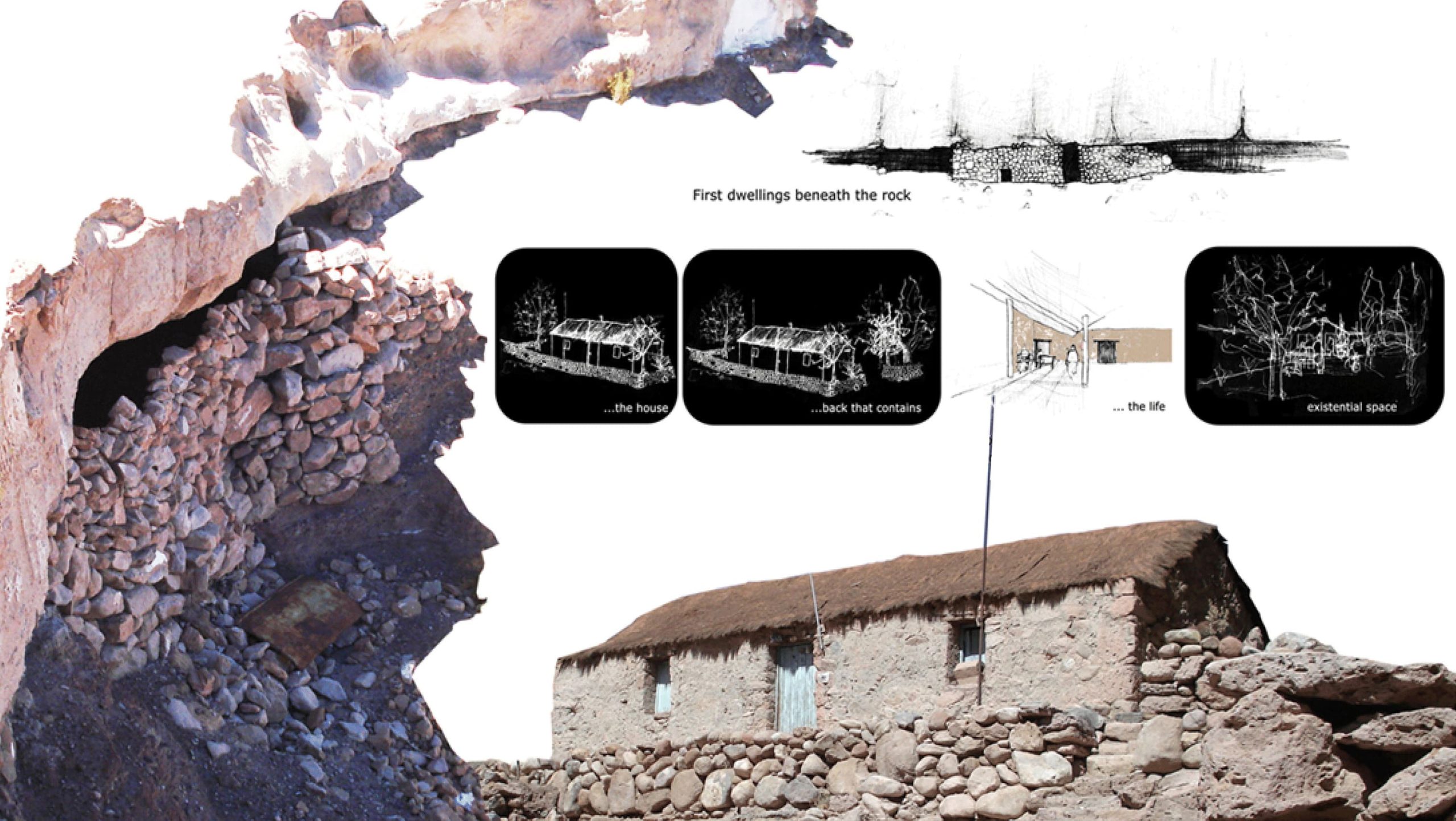
Caspana is located at 3300m above sea level, 84 km north of the city of Calama, in a fertile ravine with 47 hectares of cultivations. The village’s population dedicates it’s daily activities to the cultivation of diverse vegetables and flowers that are later sold in the city of Calama. Caspana does not count with a high school, therefore, most part of its children migrate to Calama at age 12. This is the biggest cause for migration. The villagers require other forms of education for their children in order to secure the continuity of this village and its culture.
There is no electricity in Caspana; for light, they rely on a generator from 7 to 9 pm. It is a peaceful village, made up of shepherds and farmers. Every day, Caspana receives from 60 to 200 tourists, who do not interact with the local inhabitants. This results into a situation where the town is transformed into a touristy window display for foreigners.
There is no electricity in Caspana; for light, they rely on a generator from 7 to 9 pm. It is a peaceful village, made up of shepherds and farmers. Every day, Caspana receives from 60 to 200 tourists, who do not interact with the local inhabitants. This results into a situation where the town is transformed into a touristy window display for foreigners.
The community of Caspana lives in tight communion and balance with its surroundings. Its constructions are made out of stone walls and mud roofs; the settlement is structured by a water canal maze that crosses it from east to west. The village is practically cut off from the exterior, visited only three times a week by a public transportation car that takes the villages to and from Calama. The village receives no mobile phone connection, and possesses a single telephone and Internet access at the School. Both the School and the Medical Center rely on windmills for energy.
Caspana does not posses a sewage system or a garbage collection system; in spite of this, the village is clean and healthy. The villagers use water from the river for domestic use, and it needs no treatment in order to be consumed.
Considering Caspana as an example of a vital and alive Atacamanian community, an example of an ecological settlement in the Chilean territory, and evaluating its problem of migration due to education, Caspana is established as a place for an architectonic proposal that integrates local and global cultures, in order to give the villagers of Caspana the necessary tools for their growth, future development, and continuity in time. Another goal for the project is to try and solve the form of encounter between foreign visitors and local villagers, by allowing foreigners to participate and have human contact with the local culture.
The aim is to generate a gathering space for foreigners and local villagers through a social-educational project that nourishes the local culture as well as the foreigner’s search in this locality.
The project aims to be a platform for gathering and support for two problems: on a local level, the problem of migration, and a global level, the loss of man’s essential way of inhabiting in a contemporary scene of globalization.
This is a sustainable project: sustainable in an energetic sense of the word as well as a social and cultural sense.
The project’s volumetric characteristics seek to find a correct way of opening a compact interior into an expanded exterior, and vice versa. This challenge can be taken to multiple scales, be it a macro scale, due to the relationship of the local village in an actual global world, as well as an intermediate scale, in which the project seeks to generate a public space through the contention and verticality of the gorge in the extended horizontality of the desert. Finally, the project also takes on a micro scale responsibility, which refers to the architectonic intention of generating an intermediate space as a link between the compact interiors of a construction that is vernacular to the landscape’s extension.
The project responds to the need to establish a fruitful dialogue between global and local cultures, though a strategic social educational program of a Platform for Residencies and Retreats in Caspana. This platform would house the spaces and equipment needed in order to develop international seminars for the professionals that frequently visit the Atacama Desert with academic and scientific ends, such as Anthropologists, Archeologists, Astronomers, Geologists, Artists, Architects, Geographers and Historians. The platform would also be used as a shelter for people seeking a period of silence and retrospection, or perhaps working on some specific investigation or work that requires isolation and peace.
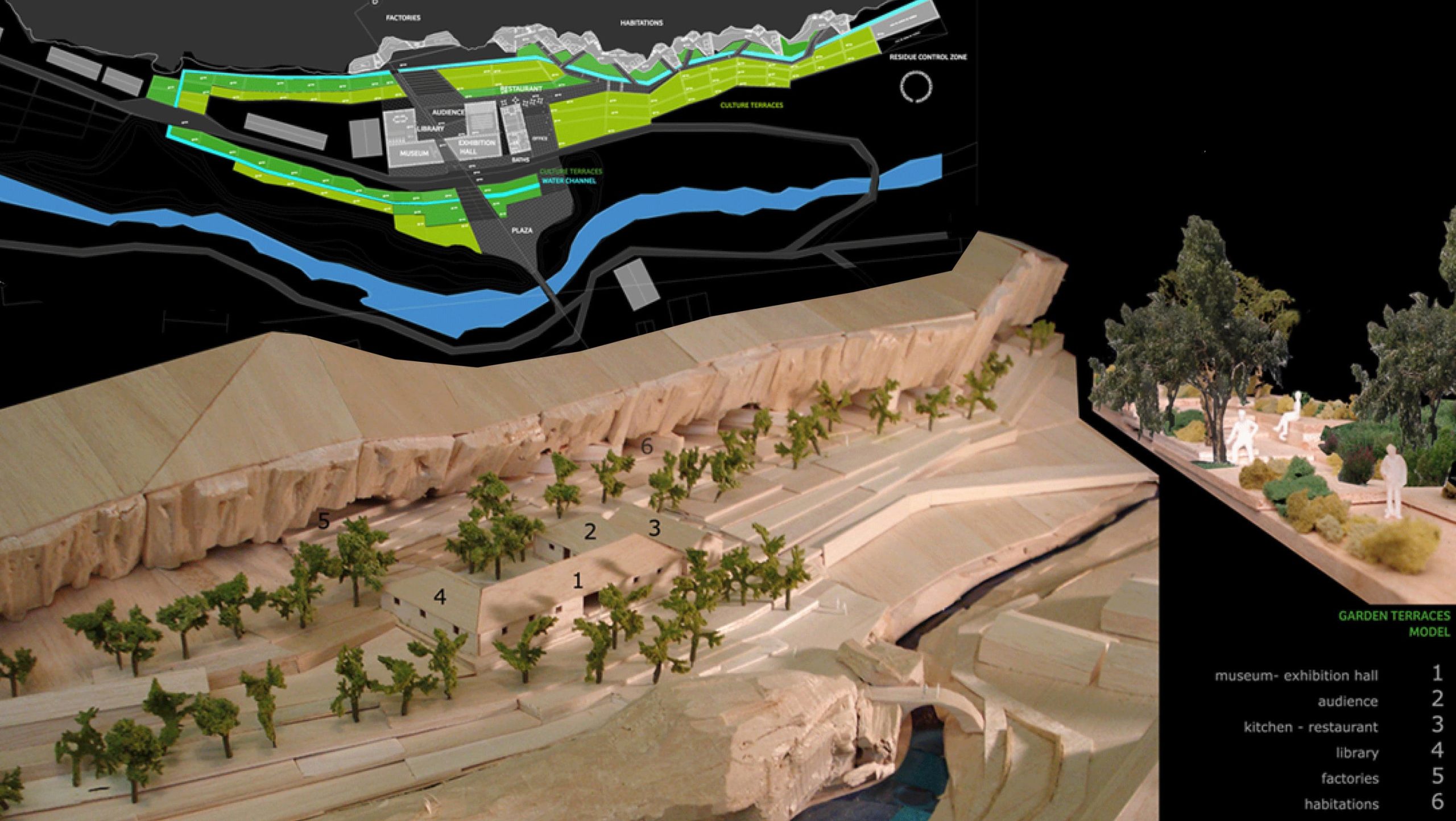
At the same time, the equipment brought to the village by this program could also be used for the educational and communicational ends of the Caspana community, leading to the development of an interactive encounter between the foreign visitor and the local people. It is an opportunity for the village of Caspana to receive this equipment, since it could turn into a new educational option in the future. This could decrease the migration of young people to the city, seeing as they would have the opportunity to develop their education in their own community, learning new languages and sharing experiences and workshops with the foreign visitors. This new educational proposal is based on the studies of Roberto Hernandez, a Chilean Anthropologist and professor at the Universidad de Chile, who works in plans for Development and Rural Education in a global context.
The project develops new cultivation terraces. These would be public terraces that are focused towards the development and investigation of the agrarian area. This space is intended for community use and aims to be an educational support for Caspana’s primary school. At the same time, this public space will count with the development of recreational green areas, called Terrace Gardens, projected for the center of the village. These green areas will serve as spaces for public gatherings in Caspana.It is essential to point out that the site of this public space is located in the cross between the gorges’ axis and the opening of a visual axis towards the expanse desert. This point of vital importance, where the main plaza stands today, will be reinforced as a place for gatherings through the Terrace Gardens, which will provide shade and different levels of ground, leading both locals and visitors to pause at this point. In this way, a human and natural encounter between Atacamanians and foreigners can take place, breaking the window display situation that the village is currently in due to the visits of buses filled with tourists, most of whom have no idea where they are and therefore observe the local reality from an abstract plane.
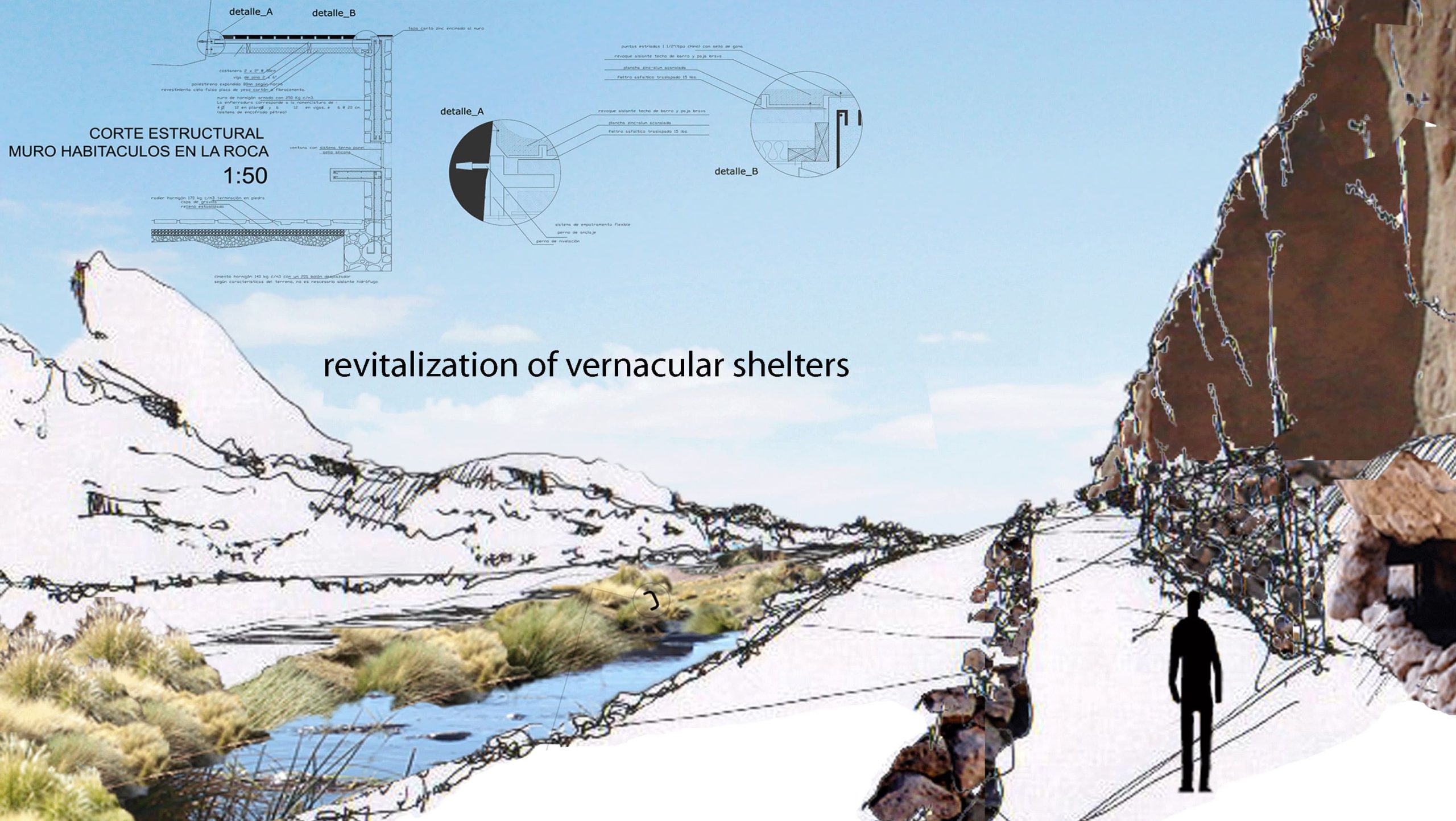
Finally, the project intends to restore and build the following program.
PART OF PROJECT (restoration and new constructions)
Prolongation of the old watering canal on the northern slope (restoration)
As an origin of the project, the old northern watering canal is rescued and prolonged in order to take water and fertilize the grounds in the center of the town, where the architectonic project will be located.
Experimental community cultivation terraces (new)
49 cultivation terraces are projected for community use in order to stimulate the development, education, and experimentation of agrarian activity.
Terrace Gardens (new)
37 Terrace Gardens are projected in order to host public space for the village on an intermediate spatiality, providing shade and located between the Gathering Plaza and the accesses to the different program buildings.
Gathering Plaza (restoration)
An open platform within the gorge that extends into the horizon of the desert through the visual opening of the access axis, perpendicular to the terrace.
Auditorium/Conference room (new program in the museum restoration)
Has a 60-person capacity, with the possibility of open-air projections for the village.
Kitchen and Restaurant (new program in the community house restoration)
A kitchen that can host local cuisine courses and a restaurant for 36 people.
Library and Study Zone (new program in the museum restoration)
Computer, books, documentaries and a study table.
Caspana Museum and Temporary Exhibitions Hall (new program in the museum restoration)
A Caspana museum and a hall for temporary exhibitions, either by local artists, foreign artists, or exhibitions of Chilean art.
Workshops (new program in the old food warehouses restoration)
Warehouses are opened up in order to house knitting, adobe, or other necessary workshops.
Rooms in the Rock (restoration)
Restoration and construction of ancient dwellings; these are transformed into 8 rooms, each with a double bed, a bathroom, a kitchen and a living room.
*Please note that this project has been developed as an Architectural Thesis for my professional degree of Architecture in Universidad Finis Terrae in Chile. And all the plans, detail and technical information created as final submittal remain private as a personal agreement with the local community of Caspana. This project was not constructed but I hope one day in the future Caspana can own a place like that, they are just beautiful people that deserve the best and the place is magical.
© All rights reserved WiLD LandArch